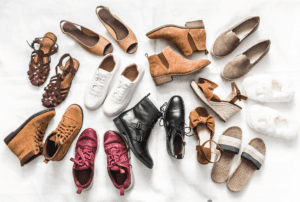Many Britons face foot discomfort due to ill-fitting shoes, leading to issues like bunions, corns, and calluses. Selecting the proper footwear prevents these problems and maintains foot health. Below are practical tips to help you find shoes that fit well and provide comfort and protection for your feet.
Essential Considerations for Footwear Selection
Foot and ankle injuries are common but can be minimised by wearing shoes that match the natural shape of your feet. Prioritise comfort and fit over style when choosing shoes to ensure your feet aren’t forced into uncomfortable positions.
Assess Your Unique Foot Characteristics
Understanding your foot anatomy is crucial to determining the support and cushioning needed.
There are three primary foot types:
Neutral Feet:
You likely have neutral feet if your arches are medium height. Opt for shoes with balanced cushioning and stability.
Flat Feet:
Low or almost nonexistent arches indicate flat feet. Look for shoes offering additional stability and motion control to support your feet effectively.
High Arches:
Pronounced high arches suggest this foot type. Choose it with extra cushioning and flexibility to accommodate your arches comfortably.
2.Determine Your Preferred Running Environment Identify
where you primarily run to select the appropriate shoe category:
Road Running:
Urban runners should opt for lightweight, cushioned shoes with reliable traction.
Trail Running:
If you enjoy off-road adventures, seek out trail-specific shoes providing superior grip, stability, and protection against uneven terrain.
3.Seek Guidance from Specialized Running Stores
Visit reputable running stores
: where knowledgeable staff can provide expert advice. They’ll conduct a gait analysis to assess your foot strike and recommend suitable shoes tailored to your needs.
Try Shoes When Your Feet Are at Their Largest
Since feet tend to swell throughout the day, try on running shoes in the afternoon or evening. This will ensure a better fit and prevent discomfort during extended runs.
Wear Appropriate Running Socks
When trying on shoes, bring or wear the socks you typically wear for running. This ensures an accurate fit, as different sock thicknesses can affect how a shoe feels.
Prioritise Comfort and Fit
:Experiment with various brands and models, considering:
Length and Width:
Ensure ample space (about a thumb’s width) between your longest toe and the shoe’s tip. The shoe should securely hold your foot without being too tight or loose.
Arch Support:
Look for shoes that support your foot’s natural arch.
Heel and Ankle Support:
Check for a snug fit around the heel and ankle that could prevent slippage.
Flexibility:
The shoe should provide flexibility at the forefoot to allow for natural movement.
4.Consider Local Terrain and Weather Conditions
Choose shoes with ample cushioning for running primarily on concrete or pavement. Additionally, consider weather conditions—opt for shoes with good traction and water resistance if you run in wet or snowy conditions.
5. Budget and Durability:
Set a budget and consider the shoes’ durability. Running shoes typically last 300-500 miles, so choose a pair that aligns with your mileage goals.
Key Recommendations for Footwear
Regular Measurements:
Have both feet measured each time you buy shoes, as foot size can change over time, especially as you age.
Heel Height:
Women should avoid heels taller than 2-1/4 inches to prevent strain on the feet and opt for lower heels to alleviate pressure.
Time of Day:
Try new shoes in the evening when your feet are slightly swollen from standing or sitting throughout the day.
Proper Fit:
Shoes should fit snugly around the heel and provide about half an inch of space in front of the longest toe.
Try Both Shoes:
Ensure to try on both shoes and walk around the store to verify that they fit comfortably and feel suitable on various surfaces.
Individual Fit:
Sizes can vary between brands and styles, so focus on how the shoe fits your foot rather than the marked size.
Toe Wiggle Room:
To avoid constriction, you should be able to freely wiggle all your toes when wearing the shoes.
No Break-in Period:
If the shoes feel tight or uncomfortable, avoid purchasing them; there’s no guarantee they will stretch or become more comfortable over time.
Consider High Heels:
High heels with pointed, narrow toe boxes can cause discomfort and pressure on the forefoot, so opt for styles with wide toe boxes or lower heel heights when possible.



